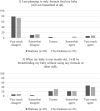Self-Efficacy and Outcomes in Women with Diabetes: A Prospective Comparative Study
- PMID: 36999939
- PMCID: PMC10124167
- DOI: 10.1089/bfm.2022.0298
Self-Efficacy and Outcomes in Women with Diabetes: A Prospective Comparative Study
Abstract
Background: Breastfeeding is especially beneficial to women with diabetes and their infants, yet diabetic mothers frequently experience less favorable breastfeeding outcomes. Objectives: To identify facilitators and barriers to breastfeeding for women with diabetes by comparing cognitive and social factors, health and hospital-related factors, and breastfeeding outcomes between women with and without diabetes. Design/Methods: Women with any type of diabetes (n = 28) and without diabetes (n = 29) were recruited during pregnancy. Data were collected from the electronic medical record and maternal surveys at 24-37 weeks' gestation, birth hospitalization, and 4 weeks' postbirth. We compared differences in mother's regard for breastfeeding, breastfeeding intention, and birth hospital experience by diabetes status, and estimated odds ratios for exclusive breastfeeding (EBF) and unmet intention to breastfeed. Results: Women with and without diabetes had similar breastfeeding intentions, attitudes, and self-efficacy. Women with diabetes were less likely to EBF, and more likely to have unmet intentions to EBF at hospital discharge, compared to women without diabetes. At 4 weeks' postpartum, there was no difference in breastfeeding by diabetes status, although EBF at hospital discharge was strongly associated with EBF at 4 weeks. Infant neonatal intensive care unit (NICU) admission and hypoglycemia were significantly associated with diabetes status, reduced EBF rates, and unmet breastfeeding intentions. Conclusions: Despite having a strong intent to breastfeed, women with diabetes experienced less favorable early breastfeeding outcomes and were less likely to meet their own breastfeeding goals. These differences may be driven by neonatal complications, such as infant hypoglycemia and NICU admissions, rather than maternal cognitive and social factors.
Keywords: breastfeeding; breastfeeding attitudes; breastfeeding intentions; breastfeeding self-efficacy; gestational diabetes.
Conflict of interest statement
No competing financial interests exist.
Figures
References
Publication types
MeSH terms
Grants and funding
LinkOut - more resources
Full Text Sources
Medical


